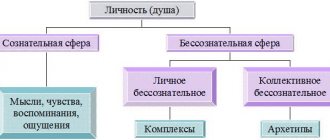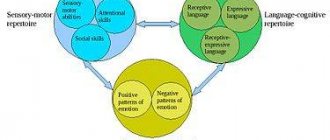Pavlov's school.
The doctrine of conditioned reflexes is a temporary connection between an external agent and the activity of the body.
Unconditioned reflexes are carried out under any conditions. Signaling systems. 1st signaling system - irritation on external receptors and on the cerebral hemispheres, common in humans and animals; The 2nd signal system is the word. Laws of GNI: law of irrationation, law of concentration. He studied experimental neuroses. Orbeli L.D. the doctrine of the 2nd signal system, the problem of labor and inspiration. Anokhin P.K. theory of functional systems, universal model of the brain (afferent synthesis), biology and neurophysiology of the conditioned reflex. Lomov B.F. special developments of instinctive psychology, occupational psychology, psychophysics, mathematics. psychology. Davydov V.V. the phenomenon of interiorization.
School of Teplov, Nebylitsyn.
Basic properties and systems according to Pavlov and Nebylitsyn. Blank methods for diagnosing the basic properties of the nervous system and their psychological characteristics.
Properties:
- The strength of nervous processes – irritable and inhibitory.
- Equilibrium of these processes.
- Their mobility.
- Highest plasticity.
Unusual, extraordinary events, irritations of great strength appear in the environment, and, naturally, the need often arises to suppress, delay the effects of these irritations at the request of other, equally or even more powerful external conditions. And nerve cells must endure these extreme stresses of their activity. This also implies the importance of balance, the equality of strength of both nervous processes. Both processes must, so to speak, keep pace with environmental fluctuations, i.e. must have high mobility, the ability to quickly, as required by external conditions, give way, give preference to one irritation over another, irritation before inhibition and vice versa.
Leontiev School.
Works on the problem of activity. This theory is most widespread in Russian psychology. Among the researchers who made the greatest contribution to its development, we should name, first of all, S. L. Rubinshtein, A. N. Leontyev, K. A. Abulkhanova-Slavskaya and A. V. Brushlinsky. This theory has a number of common features with the behavioral theory of personality, especially with its social-scientific direction, as well as with humanistic and cognitive theories.
This approach denies the biological and, especially, the psychological inheritance of personal properties. The main source of personality development, according to this theory, is activity. Activity is understood as a complex dynamic system of interactions of the subject (active person) with the world (with society), in the process of which personality properties are formed (Leontyev A. N., 1975). The formed personality (internal) subsequently becomes a mediating link through which the external influences a person (Rubinstein S.L., 1997).
The fundamental difference between activity theory and behavioral theory is that the means of learning here is not a reflex, but a special internalization mechanism, thanks to which socio-historical experience is assimilated. The main characteristics of activity are objectivity and subjectivity.
Objectivity is a characteristic that is inherent only in human activity and manifests itself primarily in the concepts of language, social roles, and values. Unlike A. N. Leontiev, S. L. Rubinstein and his followers emphasize that the activity of the individual (and the personality itself) is understood not as a special type of mental activity, but as real, objectively observable practical (and not symbolic), creative, independent activity of a particular person (Abulkhanova-Slavskaya K. A., 1980; Brushlinsky A. V., 1994).
Subjectivity means that a person himself is the bearer of his activity, his own source of transformation of the external world, reality. Subjectivity is expressed in intentions, needs, motives, attitudes, relationships, goals that determine the direction and selectivity of activity, in a personal sense, i.e., the meaning of activity for the person himself.
According to representatives of this approach, consciousness occupies the main place in personality, and the structures of consciousness are not given to a person initially, but are formed in early childhood in the process of communication and activity. The unconscious occurs only in the case of automated operations.
Within the framework of the activity approach, individual properties or personality traits act as elements of personality; It is generally accepted that personality traits are formed as a result of activities that are always carried out in a specific socio-historical context - LeontyevA. N., 1975). In this regard, personality traits are considered socially (normatively) determined. For example, perseverance is formed in activities where the subject shows autonomy and independence. A persistent person acts boldly, actively, defends his rights to independence and demands that others recognize this. The list of personality properties is virtually limitless and is determined by the variety of activities in which a person is included as a subject (Abulkhanova-Slavskaya K. A., 1980).
In the activity approach, the most popular is the four-component model of personality, which includes orientation, abilities, character and self-control as the main structural blocks.
Orientation is a system of stable preferences and motives (interests, ideals, attitudes) of an individual, which sets the main tendencies of an individual’s behavior. A person with a strong focus is hardworking and goal-oriented
Abilities are individual psychological properties that ensure the success of activities. There are general and special (musical, mathematical, etc.) abilities. Abilities are interconnected.
Character is a set of moral and volitional properties of a person. Moral qualities include sensitivity or callousness in relationships with people, responsibility in relation to public duties, modesty
Self-control is a set of properties of self-regulation associated with an individual’s awareness of himself. This block is built on top of all other blocks and exercises control over them: strengthening or weakening of activity, correction of actions and deeds, anticipation and planning of activities, etc. (Kovalev A. G., 1965).
Thus, within the framework of the activity approach, a person is a conscious subject who occupies a certain position in society and performs a socially useful public role. Personality structure is a complexly organized hierarchy of individual properties, blocks (direction, abilities, character, self-control) and systemic existential-being integral properties of the personality.
Concept of personality by A.F. Lazursky
The importance of this concept lies in the fact that for the first time a position was made about personal relationships that constitute the core of personality. Its special significance also lies in the fact that the idea of personality relationships became the starting point for many Russian psychologists, especially for representatives of the Leningrad-Petersburg school.
Views of A.F. Lazursky’s views on the nature and structure of personality were formed under the direct influence of the ideas of V.M. Bekhterev while working under his leadership at the Psychoneurological Institute.
According to A.F. Lazursky, the main task of the individual is adaptation (adaptation) to the environment, understood in the broadest sense (nature, things, people, human relationships, ideas, aesthetic, moral, religious values, etc.). The measure (degree) of activity of a person’s adaptation to the environment can be different, which is reflected in three mental levels - lower, middle and higher. In fact, these levels reflect the process of human mental development.
According to A.F. Lazursky, personality is the unity of man. F. Lazursky represents the unity of two psychological mechanisms. Firstly, this is the endopsyche - the internal mechanism of the human psyche. The endopsyche manifests itself in basic mental functions such as attention, memory, imagination, reasoning, willpower, emotionality, impulsiveness, that is, in temperament, mental abilities and, finally, in character. According to AF Azure, endocrites are mostly innate.
Another significant aspect of personality is the exopsyche, the content of which is determined by the individual’s attitude to external objects and the environment. Exopsychic manifestations always reflect the external conditions surrounding a person. These two parts are interconnected and influence each other. For example, a well-developed imagination and the ability to create, high sensitivity and excitability - all this presupposes the ability to engage in art. The same applies to the exocomplex of traits, when external living conditions dictate, so to speak, appropriate behavior.
The process of personality adaptation can be more or less successful. A.F. In connection with this principle, Lazursky identifies three psychological levels.
The lowest level is characterized by the maximum influence of the external environment on the human psyche. The environment seems to subjugate such a person to itself, without taking into account his characteristics. Thus, there is a contradiction between human abilities and acquired professional skills. The middle stage presupposes a greater ability to adapt to the environment and find one’s place in it. People who are more conscientious, have greater efficiency and initiative, choose professions that suit their inclinations and talents. At the highest stage of mental development, the adaptation process is complicated by the fact that significant stress, the intensity of mental life, forces not only to adapt to the environment, but also creates a desire to change it, modify it in accordance with one’s own desires and needs. In other words, here we are faced more with the process of creation.
Thus, the lower level produces people who are maladaptive or poorly adapted, the middle level produces people who are adapted, and the highest level produces people who are adaptive.
At the highest mental level, the exopsyche reaches the highest level of development thanks to spiritual wealth, consciousness, and coordination of mental experience, while the endopsyche forms its natural substrate. Therefore, classification is made according to exopsychic categories, more precisely, according to the main universal ideals and their characteristic varieties. The most important among them, according to A.F. Lazursky are: altruism, knowledge, beauty, religion, society, external activity, system and power.
Luria School, School of Neuropsychology.
The role of speech in the development of voluntary mental processes.
According to Luria's theory, the brain is a highly differentiated system, the parts of which are responsible for different aspects of the whole: separate areas of the cerebral cortex interact with each other to produce thoughts and actions of many different kinds. Luria assumed that the brain contains three main blocks:
- The brainstem and midbrain structures responsible for the long-term preservation of traces of excitation.
- Incoming sensory functions - receiving, processing and storing information.
- The frontal cortex is responsible for organizing, planning, and monitoring the successful execution of programs.
Afterword
The concepts discussed are similar in some ways, but completely different in others. In particular, there is no clear answer about what ultimately comes first: man or society, nature or the environment.
But if we focus on domestic concepts, we can note that a person becomes a person under the influence of society, through relationships and the assimilation of cultural experience.
You can read more about what personality is in the articles “The concept of personality in psychology: essence and structure” and “Personality orientation - what is it in psychology.”
Georgian school. Uznadze.
Uznadze, installation theory, founder of Tbilisi University. Uznadze’s concept of personality is based on the concept (attitude), which he considered the main psychological formation. Attitude is considered the main regulatory mechanism of human behavior, determining its direction and selective activity. However, the essence of personality is not reduced to the functioning of the attitude, but is determined by the presence of such fundamental manifestations as consciousness and the ability to objectify. A characteristic feature of the personality is the implementation of distant motivation, the commission of actions and deeds, the purpose of which is to satisfy the needs intended for the future life. Higher needs - intellectual, moral and aesthetic - correspond to the self-concept of a person. The attitude is manifested in the present time, although it is a certain form of anticipation.
Depending on a person’s ability to objectify, Uznadze describes three types of personalities:
- dynamic - a person who has a developed ability for objectification and is willing to easily switch in the direction of objectified goals;
- static - a person who exhibits hyper-objectification, which consists of constantly delaying the impulses of his attitudes and choosing appropriate types of activity only on the basis of volitional efforts;
- variable - a person who has sufficient ease of objectification, but does not have sufficient volitional abilities to implement it.
One of the most important characteristics of personality in Attitude Theory is responsibility, thanks to which a person can rise above his needs, acting as a subject of will. The meaning of motivation is to find an activity that corresponds to the basic personality attitude fixed in the process of life. The period of goal preparation is divided into two stages:
- a choice that is recognized as an intellectual act and is carried out on the basis of personal values of behavior for a given subject;
- motivation recognized as a volitional process. Volitional behavior is the ability of an individual to subordinate his activity not only to personal values, but also to objective necessity.
The concept of personality of A.V. Petrovsky
Leontiev’s approach to understanding personality found its further development in the works of Russian psychologists - representatives of the Moscow school, including A.N. Petrova. V. Petrovsky. In the textbook “General Psychology,” written under his editorship, there is the following definition of personality: “In psychology, personality is a systemic social quality that an individual acquires in objective activity and communication and which characterizes the level and quality of representation of social relations in an individual.”
A.V. Petrovsky in his developments proceeds from the fact that the concepts of “individual” and “personality” are not identical. Personality is a special characteristic that an individual initially acquires in society in the process of his entry into social relations. In order to understand on what basis certain personality characteristics are formed, it is necessary to consider a person’s life in society. The inclusion of an individual in the system of social relations determines the content and nature of his activities, the scope and methods of communication with other people, that is, the specifics of his social essence, his way of life. But the way of life of individual people, certain communities of people, as well as society as a whole, is determined by the historically developing system of social relations. This means that personality can be understood or studied only in the context of certain social conditions, a certain historical era. In addition, it should be noted that society is not only the external environment for the individual. The individual is constantly involved in a system of social relations mediated by many factors.
Petrovsky believes that the personality of a particular person can continue to live in other people and does not completely die with the death of the person himself. And in the words “he lives in us even after death” there is no mysticism or pure metaphor; this is a statement of the fact of the ideal representation of a person after his material disappearance.
Considering further the views of representatives of the Moscow psychological school on the problem of personality, it should be noted that by the concept of personality, in most cases, the authors meant certain qualities belonging to the individual, and precisely those qualities that determine the uniqueness of a person, his individuality. However, the concepts of “individual”, “personality” and “individuality” are not identical in content - each of them reveals a certain aspect of a person’s essence. Personality can be understood only in a system of stable interpersonal relationships, mediated by the content, values, and meaning of the joint activities of each of the participants. These interpersonal connections are real, but supersensual in nature. They manifest themselves in specific individual characteristics and actions of people included in the team, but are not limited to them.
Just as the terms “individual” and “personality” are not identical, personality and individuality, in turn, form a unity, but not an identity.
If personality traits are not represented in the system of interpersonal relations, they turn out to be of little significance for assessing personality and do not receive conditions for development, just as only those personality traits that are most “involved” in leading activities for a given social community act as personality traits. Therefore, according to representatives of the Moscow psychological school, individuality is only one aspect of a person’s personality.
Thus, there are two main points in the position of representatives of the Moscow psychological school. Firstly, personality and its characteristics are compared with the level of social manifestation of a person’s qualities and characteristics. Secondly, personality is considered as a social product that is in no way connected with biological determinants, and therefore we can conclude that the social influences the mental development of the individual to a greater extent.
Ananyev B. G. (1907-1972) - Russian psychologist.
The structure of man as an individual, personality and subject of activity. Characteristics of a person as an individual. There are grounds for identifying 2 main classes of individual properties: age-sex and individual-typical. The first includes age properties and sexual dimorphism. The second includes constitutional features; neurodynamic properties of the brain, features of the functional geometry of the cerebral hemispheres. All these properties are primary and exist at all levels including cellular and molecular. The interaction of age-sex and individual-typical properties determines the dynamics of psychophysiological functions and the structure of organic needs - these properties can be called secondary. The highest integration of all these properties is represented in temperament, on the one hand, and inclinations, on the other. Characteristics of a person as L. The starting point of the structural-dynamic properties of L is its status in society. On the basis of status and in constant interrelation with it, systems of social functions of roles and goals and value orientations are built. Role status and value orientations form the primary class of personal properties integrated by a certain structure L. These personal characteristics determine the characteristics of behavioral motivation, the structure of social behavior, constituting the 2nd row of personal properties. The highest integrated effect of the interaction of primary and secondary personal properties is a person’s character on the one hand and abilities on the other.
Basic characteristics of a person as a subject of activity. The initial characteristics are: consciousness and activity. As a theoretical subject. human activity is characterized by knowledge and skills. The highest integration of subjective properties is creativity, and the most social effects are abilities and talent.
Personality orientation
Personal orientation is understood as a mental property that expresses needs, motives, worldview, attitudes, goals of life and activity. The orientation of the individual is always socially conditioned, formed in the process of education and includes several hierarchically related forms. All forms are the motives of its activity.
K.K. Platonov considers the following to be the main forms of personality orientation:
- Worldview. A person’s system of views on objective reality;
- Belief. Conscious needs of the individual that underlie the views, principles, worldview, in accordance with which a person acts this way and not otherwise;
- Ideal. The image that a person focuses on in terms of self-education;
- Interests. Cognitive and specific focus on objects;
- Tendencies. Selective focus on any activity that the individual would like to engage in;
- Desires. State of motivation - needs are correlated with a specific subject for their satisfaction;
- Attractions. An insufficiently conscious need, but one that motivates action.
A common characteristic of living beings is activity, through which they maintain a vital connection with the outside world. The source of this activity is human needs, which are social and personal in nature.





